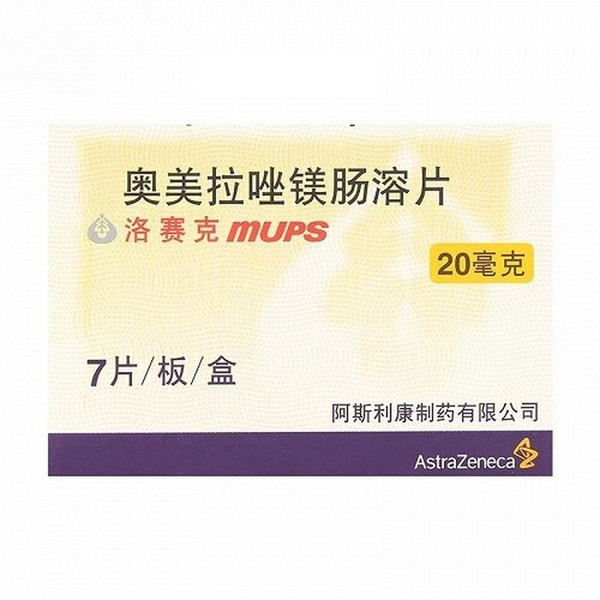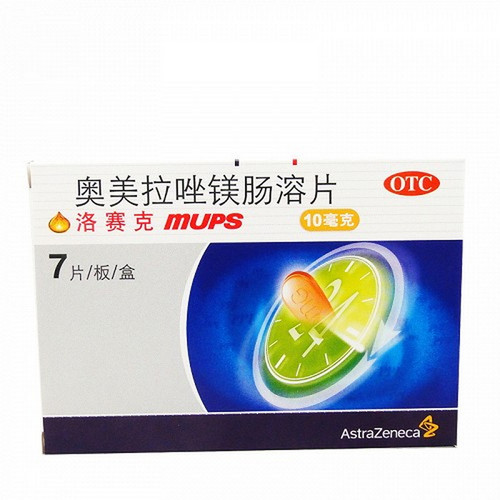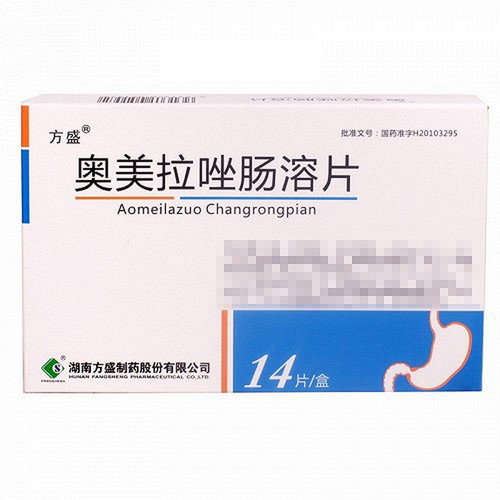Product Overview
[Drug Name]
Trade Name: Luosai Ke
English Name: Omeprazole Magnesium Enteric-coated Tablets
Chinese Pinyin: AoMeiLaZuoMeiChangRongPian (LuoSaiKe)
[Ingredients]
The main ingredient of this product is omeprazole magnesium. Its chemical name is: Bis-5-methoxy-2-{[(4-methoxy-3,5-dimethyl-2-pyridyl)methyl]sulfinyl}-1H-benzimidazole magnesium. Molecular formula: C34H36N6MgO6S2. Molecular weight: 713.21
[Properties]
This product is a biconvex, oval, enteric-coated tablet with a marking (not shown, see package insert) on one side and "10mG" or "20mG" on the other side. Each tablet contains 10.3mg or 20.6mg of omeprazole magnesium, respectively, equivalent to 10mg or 20mg of omeprazole. The 10 mg tablets are light pink, and the 20 mg tablets are pink. Dosage Form Characteristics: Omeprazole is unstable in acidic environments, so the oral dosage form consists of enteric-coated micropellets. The enteric-coated micropellets are very small, with approximately 1,000 of them contained in each 20 mg oral tablet.
[Indications]
Indicated for gastric ulcers, duodenal ulcers, stress ulcers, reflux esophagitis, and Zollinger-Ellison syndrome (gastrinoma).
[Dosage and Administration]
The tablets must be swallowed whole with at least half a cup of liquid. Do not chew or crush the tablets. Disperse them in water or a slightly acidic liquid (e.g., juice). The dispersion must be consumed within 30 minutes. Duodenal ulcers: The usual dose is 20 mg once daily. Ulcers typically heal within two weeks. If the initial course of treatment is inconclusive, treatment should be continued for another two weeks. For duodenal ulcers that have not responded to other medications, 40 mg once daily is used; it typically heals within four weeks. For patients with recurrent disease, treatment can be repeated. (See package insert for details.)
[Adverse Reactions]
This product is well tolerated. Common adverse reactions include diarrhea, headache, nausea, abdominal pain, flatulence, and constipation. Rarely, elevated serum aminotransferases (ALT, AST), rash, dizziness, drowsiness, and insomnia may occur. These adverse reactions are generally mild, resolve spontaneously, and are unrelated to dosage.
[Contraindications]
This product is contraindicated in patients with allergies, severe renal insufficiency, and infants.
[Precautions]
1. When peptic ulcers are suspected, confirm the diagnosis with X-rays and endoscopy as soon as possible to avoid inappropriate treatment. 2. When treating gastric ulcers, malignancy must be excluded. This product can mask symptoms and delay diagnosis. When a gastric ulcer is suspected, malignancy must be excluded if one or more of the following warning symptoms occur: significant, unintentional weight loss; recurrent vomiting; dysphagia; hematemesis or melena. 3. This product is ineffective for gastrointestinal motility disorders. 4. For patients with endoscopically confirmed esophagitis who are taking omeprazole long-term, the remission rate is lower with 10 mg daily compared to 20 mg daily. Therefore, patients taking 10 mg daily should undergo regular endoscopic examinations while awake. Please read the package insert carefully and use as directed by your doctor.
[Use in Special Populations]
Precautions for Children:
Currently, there is no experience with the use of this drug in children in China.
Precautions for Pregnancy and Lactation:
Epidemiological studies have shown that omeprazole has no adverse effects on pregnant women or healthy fetuses/neonatals. Omeprazole can be used during pregnancy. Omeprazole is excreted in breast milk, but its effects on infants are unknown. Use with caution in breastfeeding women.
Precautions for the Elderly:
No dose adjustment is required for elderly patients.
[Drug Interactions]
1. Due to its effect on gastric pH, this drug may affect the absorption of other drugs. Therefore, the absorption of ketoconazole and itraconazole may be reduced during treatment with omeprazole or other acid suppressants or antacids. 2. This drug is metabolized in the liver by the CYP2C19 enzyme and may increase the plasma concentrations of other drugs metabolized by this enzyme, such as diazepam, phenytoin, and warfarin (R-warfarin, low activity). Patients currently receiving phenytoin, warfarin, or other vitamin K antagonists should be monitored when initiating or discontinuing omeprazole. (See package insert for details.)
[Pharmacological Action]
Proton pump inhibitor. This drug is a lipid-soluble, weakly alkaline drug that is readily concentrated in acidic environments. Therefore, after oral administration, it is specifically distributed in the secretory tubules of the gastric parietal cells. In this highly acidic environment, it is converted to its active sulfenamide form. This form then irreversibly binds to the sulfhydryl group of the H+, K+-ATPase (also known as the proton pump) in the parietal cell secretory membrane via a disulfide bond, forming a sulfenamide-proton pump complex. This complex inhibits the enzyme's activity and blocks the final step in gastric acid secretion. Therefore, this drug has a strong and long-lasting inhibitory effect on gastric acid secretion caused by various factors. (See package insert for details)
[Storage]
Sealed, store below 25°C
[Specifications]
20 mg x 7 tablets (Losec)
[Packaging]
Double aluminum-plastic composite blister pack, 20 mg x 7 tablets/box
[Expiration Date]
36 months
[Approval Number]
National Medical Products Administration Approval Number: HJ20181233
[Manufacturer]
Manufacturer: AstraZeneca Pharmaceuticals Ltd.








